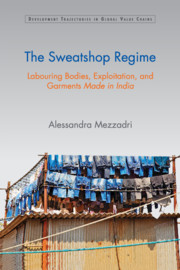Book contents
- Frontmatter
- Dedication
- Contents
- List of Tables, Figures and Pictures
- Acknowledgements
- List of Abbreviations
- Introduction
- 1 The Chain and the Sweatshop
- 2 The Commodity and the Sweatshop
- 3 Difference and the Sweatshop
- 4 The Regional Lord and the Sweatshop
- 5 The Broker and the Sweatshop
- 6 The Body and the Sweatshop
- Conclusions
- References
- Index
5 - The Broker and the Sweatshop
Published online by Cambridge University Press: 23 July 2017
- Frontmatter
- Dedication
- Contents
- List of Tables, Figures and Pictures
- Acknowledgements
- List of Abbreviations
- Introduction
- 1 The Chain and the Sweatshop
- 2 The Commodity and the Sweatshop
- 3 Difference and the Sweatshop
- 4 The Regional Lord and the Sweatshop
- 5 The Broker and the Sweatshop
- 6 The Body and the Sweatshop
- Conclusions
- References
- Index
Summary
Labour brokers come in all guises … Jobbers have not disappeared from the industrial economy; on the contrary, they are still emphatically present in the informal sector where they fill a key role.
(Breman, 1999, p. 413)Sweatshop Corridors to the ‘Global Village’ and the Reserve Army of Homes
The world of the sweatshop is always a chaotic one. Production rhythms are hectic, delivery deadlines tight and all different garmenting activities need to be coordinated with careful precision. Everywhere in India – that is, across all the different floors of the India garment mall – this is a challenging task. Indeed, coordination is particularly crucial where the sweatshop is composed of multiple realms of production and work. In these cases, the local production chain or network is extremely composite and fragmented and the socio-economic and geographical boundaries of the sweatshop are extremely fluid and porous. Moreover, the movement of both garment commodities and labourers in and out of the local sweatshops analyzed may draw a much wider geography than that encapsulated by the main industrial site linked to final markets. Economic activities may be subject to processes of ‘spatialization’ that spans well beyond single production hubs. So far, our sketch of the Indian garment mall has mainly taken into consideration key garment-producing centres or ‘clusters’; particularly those linked to export. However, the ‘networks of accumulation and survival’ (see Meagher, 2006, 2010, 2011) linked to these clusters may stretch across a constellation of different production sub-nodes. Undoubtedly, garment-producing centres impact livelihoods far beyond their primary centre of gravity. For instance, in Tamil Nadu, the ‘Tiruppur effect’ had profound implications on livelihoods in surrounding villages (Carswell and De Neve, 2013a; Heyer, 2013). There, the economic boom of the T-shirt town had indirect repercussions on wage rates as well as highly differential access to social mobility and new socio-economic opportunities (Heyer, 2012, 2013; Carswell, 2013). After all, many garment clusters crucially depend upon surrounding areas and subsidiary centres to sustain their process of accumulation (Mezzadri, 2014a).
- Type
- Chapter
- Information
- The Sweatshop RegimeLabouring Bodies, Exploitation and Garments <I>Made in India</I>, pp. 132 - 158Publisher: Cambridge University PressPrint publication year: 2016



